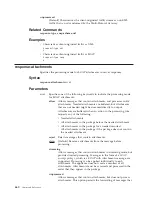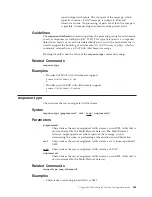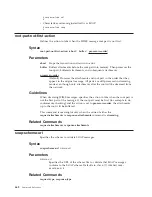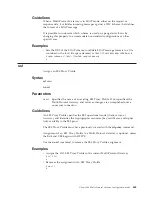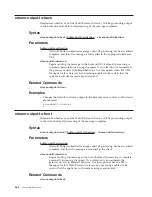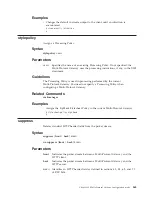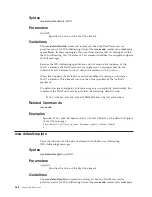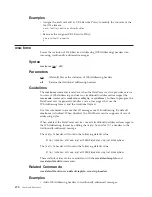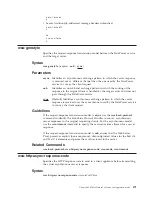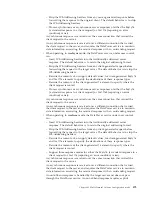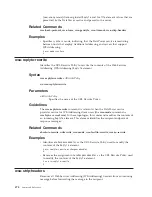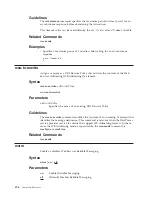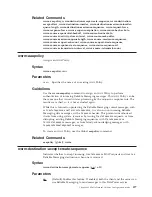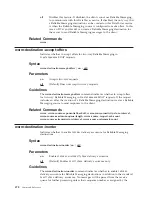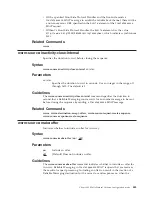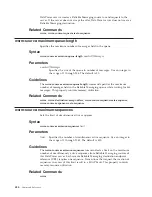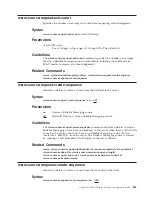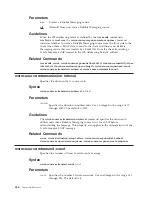
– Strip the WS-Addressing headers from any server-generated response before
forwarding the response to the original client. The default behavior is to strip
the WS-Addressing headers.
– Process synchronous or asynchronous server responses of either the
ReplyTo
(a standard response to a client request) or
FaultTo
(reporting an error
condition) variety.
A synchronous response is received over the same connection that carried the
client request to the server.
An asynchronous response is received over a different connection that carried
the client request to the server, and requires the DataPower service to maintain
state information associating the received response with an outstanding request.
v
When operating in
wsa2sync
mode, the DataPower service, under user control,
can:
– Insert WS-Addressing headers into the traditionally addressed server
response. The default behavior is to retain the original addressing format.
– Strip the WS-Addressing headers from any client-generated request before
forwarding the request to the target server. The default behavior is to strip the
WS-Addressing headers.
– Rewrite the contents of, or supply default values, for client-generated
ReplyTo
and
FaultTo
elements to specify the destinations of these response types.
– Rewrite the contents of the client-generated
To
element to specify where the
client request is routed.
– Process synchronous or asynchronous server responses of either the
ReplyTo
(a standard response to a client request) or
FaultToA
(reporting an error
condition) variety.
A synchronous response is received over the same connection that carried the
client request to the server.
An asynchronous response is received over a different connection that carried
the client request to the server, and requires the DataPower service to maintain
state information associating the received response with an outstanding request.
v
When operating in
wsa2wsa
mode, the DataPower service under user control,
can:
– Insert WS-Addressing headers into the traditionally addressed server
response. The default behavior is to retain the original addressing format.
– Strip the WS-Addressing headers from any client-generated request before
forwarding the request to the target server. The default behavior is to strip the
WS-Addressing headers.
– Rewrite the contents of, or supply default values, for client-generated
ReplyTo
and
FaultTo
elements to specify the destinations of these response types.
– Rewrite the contents of the client-generated
To
element to specify where the
client request is routed.
– Support three response modes for either the
ReplyTo
(a standard response to a
client request) or
FaultTo
(reporting an error condition) variety.
A synchronous response is received over the same connection that carried the
client request to the server.
An asynchronous response is received over a different connection that carried
the client request to the server, and requires the DataPower service to maintain
state information associating the received response with an outstanding request.
An out-of-band response is handled by the target server and does not pass
through the DataPower service. An out-of-band response requires explicit
Chapter 49. Multi-Protocol Gateway configuration mode
473
Summary of Contents for WebSphere XS40
Page 1: ...WebSphere DataPower XML Security Gateway XS40 Command Reference Version 3 7 2 ...
Page 2: ......
Page 3: ...WebSphere DataPower XML Security Gateway XS40 Command Reference Version 3 7 2 ...
Page 44: ...18 Command Reference ...
Page 194: ...168 Command Reference ...
Page 198: ...172 Command Reference ...
Page 206: ...180 Command Reference ...
Page 210: ...184 Command Reference ...
Page 222: ...196 Command Reference ...
Page 232: ...206 Command Reference ...
Page 238: ...212 Command Reference ...
Page 268: ...242 Command Reference ...
Page 272: ...246 Command Reference ...
Page 276: ...250 Command Reference ...
Page 288: ...262 Command Reference ...
Page 292: ...266 Command Reference ...
Page 298: ...272 Command Reference ...
Page 320: ...294 Command Reference ...
Page 322: ...296 Command Reference ...
Page 340: ...314 Command Reference ...
Page 344: ...318 Command Reference ...
Page 352: ...326 Command Reference ...
Page 360: ...334 Command Reference ...
Page 368: ...342 Command Reference ...
Page 376: ...350 Command Reference ...
Page 386: ...360 Command Reference ...
Page 392: ...366 Command Reference ...
Page 396: ...370 Command Reference ...
Page 402: ...376 Command Reference ...
Page 404: ...378 Command Reference ...
Page 408: ...382 Command Reference ...
Page 446: ...420 Command Reference ...
Page 450: ...424 Command Reference ...
Page 456: ...430 Command Reference ...
Page 520: ...494 Command Reference ...
Page 536: ...510 Command Reference ...
Page 550: ...524 Command Reference ...
Page 584: ...558 Command Reference ...
Page 600: ...574 Command Reference ...
Page 605: ... timeout 500 Chapter 63 RADIUS configuration mode 579 ...
Page 606: ...580 Command Reference ...
Page 650: ...624 Command Reference ...
Page 668: ...642 Command Reference ...
Page 704: ...678 Command Reference ...
Page 714: ...688 Command Reference ...
Page 726: ...700 Command Reference ...
Page 734: ...708 Command Reference ...
Page 752: ...726 Command Reference ...
Page 756: ...730 Command Reference ...
Page 804: ...778 Command Reference ...
Page 880: ...854 Command Reference ...
Page 892: ...866 Command Reference ...
Page 912: ...886 Command Reference ...
Page 918: ...892 Command Reference ...
Page 940: ...914 Command Reference ...
Page 946: ...920 Command Reference ...
Page 974: ...948 Command Reference ...
Page 1004: ...978 Command Reference ...
Page 1030: ...1004 Command Reference ...
Page 1032: ...1006 Command Reference ...
Page 1065: ......
Page 1066: ... Printed in USA ...


